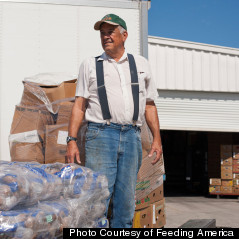In the U.S. today, 70 billion pounds of good, edible food go to waste each year. That means that nearly 40 percent of all food that is grown, harvested and produced is filling landfills rather than feeding people. At the same time this food is going to waste, 49 million people in our nation face hunger. It is unacceptable that anyone goes hungry when the 70 billion pounds -- or approximately 58 billion meals -- we waste is more than enough to feed every person facing hunger. That's why we have made it our goal to rescue as much food as possible to get it onto the plates of people in need.
For many of us, when we think of food waste we're reminded of our mothers telling us to eat our vegetables, lest they go to "waste." In reality, that kind of food waste is minute compared to the large amounts of good, safe food unused by farmers, manufacturers and retailers each year. Feeding America is in a unique position to efficiently and effectively rescue food. We have strategic partnerships with the food industry that enable us to work with people at every step of the food production process to secure surplus food that would otherwise go to waste - and as a result we are able to rescue 2.5 billion pounds of food each year. That translates to approximately 2 billion meals we can provide to people facing hunger.

An example of keeping fresh produce from being plowed under within the agriculture sector is the many acres of sweet corn which was rescued from passed fields by Second Harvest Heartland Food Bank in Minnesota by working with Seneca Foods. At the manufacturing step in the food processing supply chain, an example of food rescue is Del Monte who successfully captures peach slices that are undersized for their branded specifications and cans them for food banks, saving that nutritious product from the waste stream.
Through innovative monitoring and tracking technology, a network of 200 food banks across the country, a dedicated volunteer force and one of the largest fleets of trucks in the nation that helps move rescued food safely and efficiently, we have managed to rescue billions of pounds of food.
We have also developed innovative strategies to safely secure traditionally difficult perishable foods like meats, fresh fruits and vegetables. Two to three times a week, we rescue perishable items using Safe Food Handling Guidelines from more than 16,000 retail stores across the country. Rescuing fresh foods allows us to provide the people we serve with more nutritious options. We believe that all the people we serve should not only have food to fill their stomachs, but also the food they need to live active, healthy lives.
Despite our best efforts we realize that too much good food is still going to waste while too many people are going hungry. One in six people in our nation struggle with hunger while 70 billion pounds are still going to waste. Consequently, we are inspired to continuously build our capacity for food rescue and engage the food industry in supporting our mission.
Together, we can rescue enough food to make sure no one in our nation goes to bed hungry ever again.
Feeding America is a partner of Cisco CSR. Cisco sponsors The Huffington Post's ImpactX section.